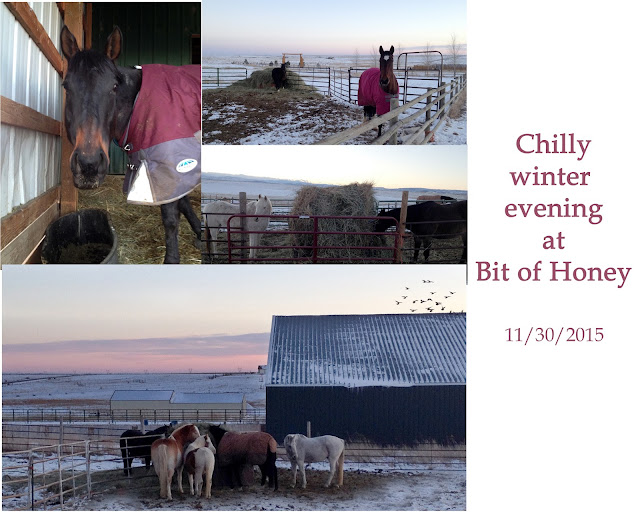It has been cold here for several days, like with highs in the twenties, and we've gotten about four inches of snow since Thanksgiving last week. Some of it has melted, most of it has blown away. There is just enough left to get some photos of my horses all bundled up in blankets (the ones that don't grow fur), and everyone is hovering around their giant hay bales like hobos keeping warm over a fire in a metal barrel.
Several of the horses here are hard keepers, or horses who have to work harder to keep warm and thus have trouble keeping weight on. I know many humans who would be thrilled to borrow the Thoroughbred metabolism around the holidays, but since it doesn't seem to be something that we can exchange between species I have to accommodate for the burning of extra calories. Basically,the hard keepers don't grow much of a winter coat, so they either shiver to burn energy to warm themselves up, or they run around to warm themselves. To combat this hemorrhaging of body condition I blanket them to keep them warm and make up for their minimal fur. I feed unlimited hay so that it ferments in their gut and heat is released inside their bodies to keep them warm. I also change their regular mash to hot mash by making it with hot water. Increasing the amount of food that the hard keepers eat in the cold weather is good too, but I have to be careful to increase the correct things. The high fiber foods such as hay and beet pulp are the best for increasing body heat and adding safe calories. Things like oats, corn, and other grains actually don't ferment the same and don't warm the horse like high fiber feeds. When I make the beet pulp mash with hot water it becomes a tasty steamy and fragrant meal.
It's entertaining to introduce a new horse to hot mash. Since I feed the hard keepers mash twice daily throughout the year (especially if they are working and in training) they are used to eating it, and they happily follow me over to the dish at meal time expecting the usual cuisine. The only change is when the temperatures get this low and I switch the liquid to hot water instead of cold.
As I present a new horse with hot mash for the first time it's always a bit of a spectacle. I dump the concoction into the feed tub, and of course that releases steam in a large white puff, then gradual tendrils of warm moisture rise up from the bucket. The new horse will back up quickly, the shock of this presentation usually elicits a good honk and a snort from the surprised equine. Then the horse will tilt his head sideways, eyeballing the witch's brew and alternately looking at me with the question of "What have you DONE to my meal?!" It doesn't usually take long before he gets closer to take a sniff, then a small bite, and before I know it the horse is diving into the food and slurping up the broth with gusto. A friend once accurately described the accompanying noises as the sound of a toilet being plunged.



No comments:
Post a Comment